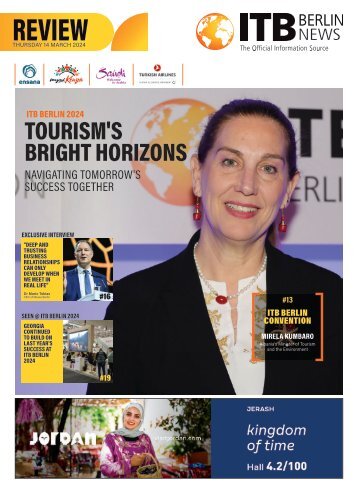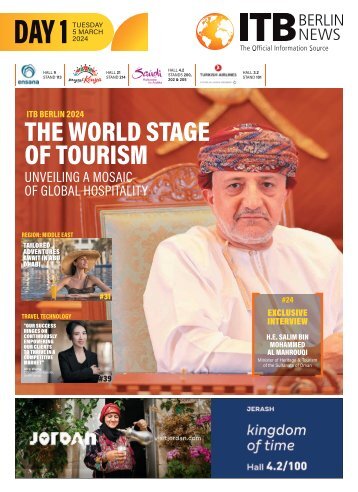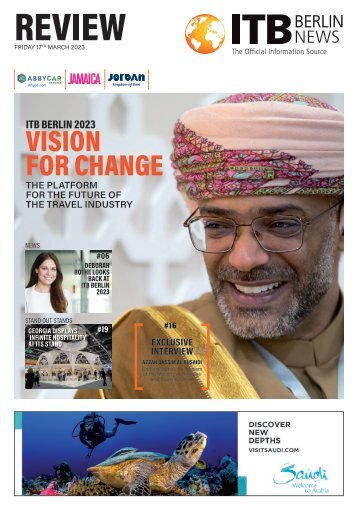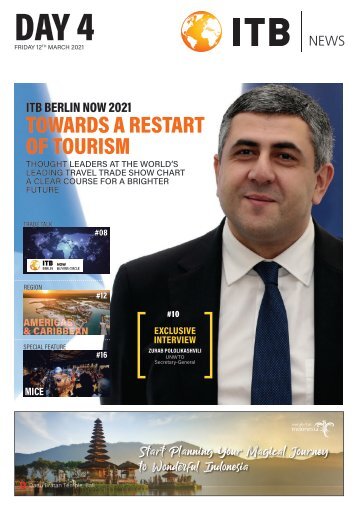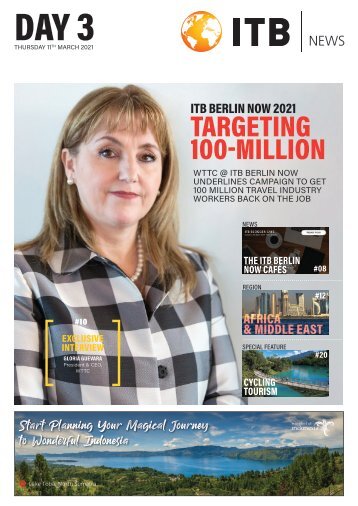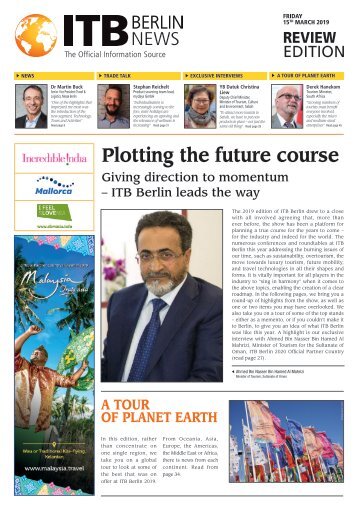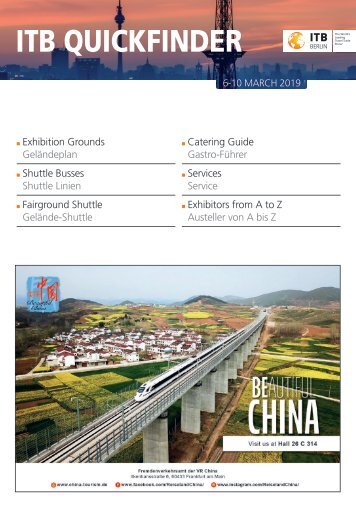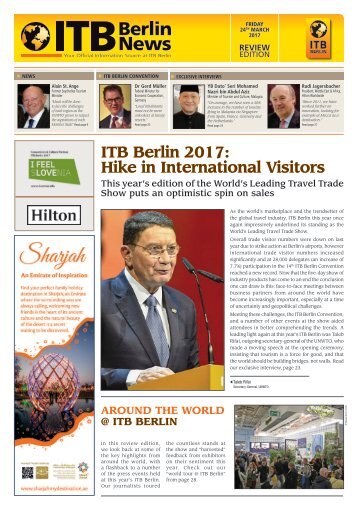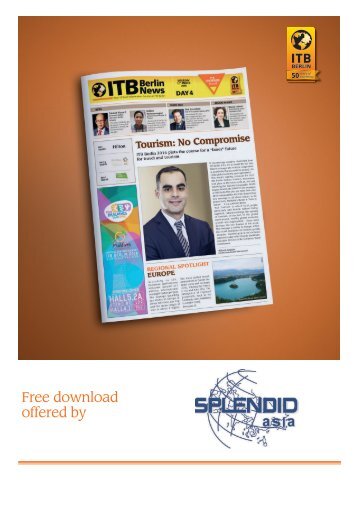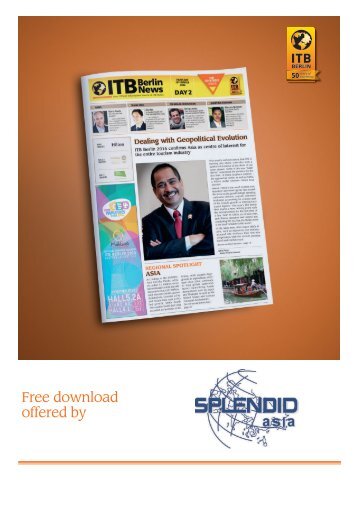
ITB Berlin News 2018 - Day 2 Edition
- Text
- Tourism
- Berlin
- Destination
- Region
- Destinations
- Buyers
- Travellers
- Arrivals
- Gastronomy
- Luxury
- Www.cleverdis.com
38 REGION ASIA Brought
38 REGION ASIA Brought to you by ITB China Official partner of the EU-China Tourism Year 2018 ITB China has been appointed the official partner of EU-China Tourism Year (ECTY). Europe is the largest exhibitor at the coming ITB China in Shanghai underlying the rising importance of the newly established travel event. An agreement about cooperation between ITB China and the European Travel Commission was signed in February 2018 by Eduardo Santander, Executive Director of the European Travel Commission and David Axiotis, General Manager of ITB China to promote the recently launched EU China Travel Year 2018 (ECTY). The event is designed to help EU and Chinese tourism businesses, authorities and all other stakeholders participating in successful commercial and cultural exchanges between the European Union and China. “To enhance the visibility of the European countries as appealing travel destinations in Greater China and promote mutual exchanges between Europe and China, I see the EU-China Tourism Year as the best initiative one can think of and ITB China as the best marketplace to be that connecting bridge between the prospering Chinese travel market, the world and specifically Europe”, stressed Axiotis, following the signature ceremony. While estimates of numbers of Chinese travellers in Europe diverge, recent analysis points to a total of six million Chinese holidaymakers coming to Europe in 2017. By teaming up, ITB China and the ECTY set the scene to further strengthen and expand Europe’s relationship with China. A dedicated Europe Pavilion will be showcasing a multitude of European tourism products and destinations. ITB China’s second edition is due to attract 15,000 attendees. From that number, 58% are buyers, 23% delegates and 17% sellers representing some 850 exhibitors – companies or destinations. ITB China invites as well some 850 top hand-selected buyers from Greater China (China PRC, Hong Kong, Macau and Taiwan). The first ITB China marked its successful premiere in 2017 and proved its importance as China’s new marketplace for the travel industry. “ITB China is turning into the top event for the tourism and travel trade looking at working with China’s travel companies”, explained Dr. Christian Göke, CEO of Messe Berlin during the ITB Berlin Opening Press Conference China online travel agency Ctrip observed in a study that China outbound travel is already coming of age with the emergence of second-tier cities as fast expanding travel markets. Ctrip is not only the largest online travel agency in Asia. The company is also ITB China’s main partner and is for the first time present at ITB Berlin. The company recently released its “2017 China Outbound Tourism Travel Report” in cooperation with China Tourism Academy (CTA), a specialised institute under the China National Tourism Administration (CNTA), highlighting the importance of China travel. China outbound tourism reached a total of 130 million trips last year, up 7% over 2016. Spending on holiday was estimated at US5.29, up by 5%. China is rapidly turning into a mature travel market, illustrated by the rise in independent travel (Free Independent Traveller or FIT) and the emergence of second-and third-tier cities as outbound markets. While the first trend highlighted by Ctrip is certainly influenced by the fact that the agency operates only online – attracting more FIT travellers than conventional sales channels - the emergence of secondary cities as outbound markets is a long-term trend. With air connectivity improving to and from secondary cities and rising purchasing power all across the country, there is a new wave of travellers emerging from cities outside China’s big metropolitan areas (Beijing, Chengdu, Guangzhou, Shanghai and Shenzhen). According to Ctrip data, Xian and Changsha saw outbound travel growing respectively by 323% and 235% last year. Sichuan capital Chengdu generates now more outbound travellers than Guangzhou and Shenzhen and is the third largest overseas travel source after Beijing and Shanghai. Chinese favourite destinations in 2017 included Thailand, Japan, Singapore, Malaysia, the Philippines, Vietnam, Indonesia, Korea, Maldives and the USA. However, Chinese are increasingly attracted by new destinations such as Mexico, Morocco, Turkey, Tunisia and the UAE Hall 9 / Stand 108 Ctrip’s CEO Jane Sun spoke at ITB Asia 2017 Opening Keynote Ctrip Sees China Outbound Market Maturing ITB BERLIN NEWS • Thursday 8 th March 2018 www.itb-berlin-news.com
Brought to you by ASIA REGION 39 Indonesia Targeting 17 Million Visitors in 2018 Ubud © 2017 Cleverdis Indonesia welcomed 14 million visitors in 2017 and has unveiled ambitious targets to increase numbers in 2018 and beyond. In an exclusive ITB Berlin interview with Arief Yahya, Indonesia’s Minister of Tourism, we asked him to tell us about the country’s plan to develop its offering. 2017 was a good year for tourism arrivals to Indonesia. Despite the usual fluctuating visitors number each month, we obtained 93.6% of the target of 15 million visitors. In terms of growth, Indonesia’s performance is three times higher compared to the regional (Southeast Asia) and global growth. In 2017, we welcome 14 million visitors, a doubledigit increase of 21.9% from the number in 2016. This year, we set the target of 17 million visitors to visit our country. How important is tourism to the Indonesian economy? Tourism is the second top leading sector of Indonesia’s economy. In 2016, the tourism sector contributed 4.5% to Indonesian GDP, earned around .6 billion from international visitor arrivals, and generated 11.8 million jobs at all skill levels. In 2018, tourism is projected to create jobs for 12.6 million people and contribute 5.3% to Indonesian GPD. Please tell us about some of the tourism infrastructure upgrades. Indonesia’s National M e d i u m - T e r m Development Plan 2015- 2019, the third phase of the National Long-Term Development Plan 2005- 2025, states that Indonesia requires 0.6 billion worth of infrastructure investment in the 2015- 2019 period. Arief Yahya Minister of Tourism, Indonesia PRIORITY PROJECTS FOR 2018 INCLUDE OVER 750KM OF NATIONAL ROADS Priority projects for 2018 include over 750km of national roads, while ongoing work at the country’s largest airports and within its vast port network also indicates measurable improvements to the national transport network. What is new from Indonesia at ITB Berlin this year and what do you hope to achieve? Representatives of 130 Indonesia tourism industries are joining the Pavilion of Indonesia. They are from travel agents/tour operators, hotels/resorts, DMOs, and also the Tourism Office of Regional Governments. The National carrier, Garuda Indonesia, also joins in to promote its direct flight routes from cities in European countries Hall 26a / Stand 114-116 BALI: NO TREMOR FOR TOURISM ACTIVITIES AFTER AGUNG VOLCANO ERUPTION Bali made headlines at the end of last year due to the eruption of Volcano Agung, and although international air arrivals declined by 9.6% in November and 29.7% in December, Indonesia’s tourism icon still managed to grow total arrivals by 16% last year. Each year over the past five years has brought new records for Bali, and 2017 was no exception to the rule. According to data collected by Indonesia’s Ministry of Tourism, Bali last year welcomed 5.6 million international arrivals, a number up by 16.3%, confirming its flagship status of Indonesia tourism. The island alone generates over 40% of all international tourist arrivals to the country, far ahead of Jakarta, Indonesia’s second most visited destination with 2.88 million arrivals, or 20% of market share. The tremendous rise of Chinese, Russian and Indian tourist numbers helped mitigate the effects of the Agung volcano on the island’s tourism. In 2017, Chinese travellers generated 1.37 million arrivals followed by Australia with 1.06 million visitors. India is now the third largest market to Bali as it generated 265,000 arrivals last year. Other important markets to Bali are the UK, USA, France, Germany, South Korea and Singapore. As the volcano issue failed to deter the popularity of Bali, growth in arrivals already resumed in January and February. After being worried at the end of the year by declining occupancy rates, Bali’s hotel industry looked with optimism into the future. According to a report of Horwath HTL/ C9 Hotelworks’ on Bali’s hotels released early February, the island will continue to witness growth in arrivals. The report notes that the influx of visitors had a positive effect on Bali hotel performance. From January to October 2017, the RevPAR (Revenue per available room) was up 7% while the average occupancy reached 75% - a growth of three points over 2016. Bali will add some 13,000 rooms by 2020, increasing its hotel portfolio from 42,000 to 55,000 rooms. 2018 will see nearly 6,000 rooms in 38 hotels being added Hall 26a / Stand 114-116 ITB BERLIN NEWS • Thursday 8 th March 2018
- Page 1: THURSDAY 8 th MARCH 2018 DAY 2 EDIT
- Page 7 and 8: NEWS 7 © TMV/Danny Gohlke Tourists
- Page 10 and 11: 10 NEWS ADVERTORIAL Majda Rozina Do
- Page 12 and 13: 12 ITB BERLIN CONVENTION Doug Lansk
- Page 14 and 15: 14 EXCLUSIVE INTERVIEW THE BIGGEST
- Page 16 and 17: 16 EXCLUSIVE INTERVIEW ADVERTORIAL
- Page 19 and 20: SPECIAL FEATURE CRUISES 19 Cruise B
- Page 21 and 22: ADVERTORIAL SPECIAL FEATURE CRUISES
- Page 23: SPECIAL FEATURE LUXURY ACCOMODATION
- Page 27: SPECIAL FEATURE GASTRONOMY & WINE T
- Page 30 and 31: 30 SPECIAL FEATURE GASTRONOMY & WIN
- Page 33 and 34: Brought to you by ASIA REGION 33 Ch
- Page 35: Brought to you by ASIA REGION 35 In
- Page 41: Brought to you by ASIA REGION 41 Th
- Page 45 and 46: Brought to you by ASIA REGION 45 Ja
- Page 47: Brought to you by ASIA REGION 47 AD
- Page 50 and 51: 50 REGION ADVERTORIAL ASIA Brought
- Page 52 and 53: 52 SPOTLIGHT ON GERMAN REGION: BAVA
- Page 54: 54 Hospitality Chaussee36 - Bedroom
Inappropriate
Loading...
Mail this publication
Loading...
Embed
Loading...
